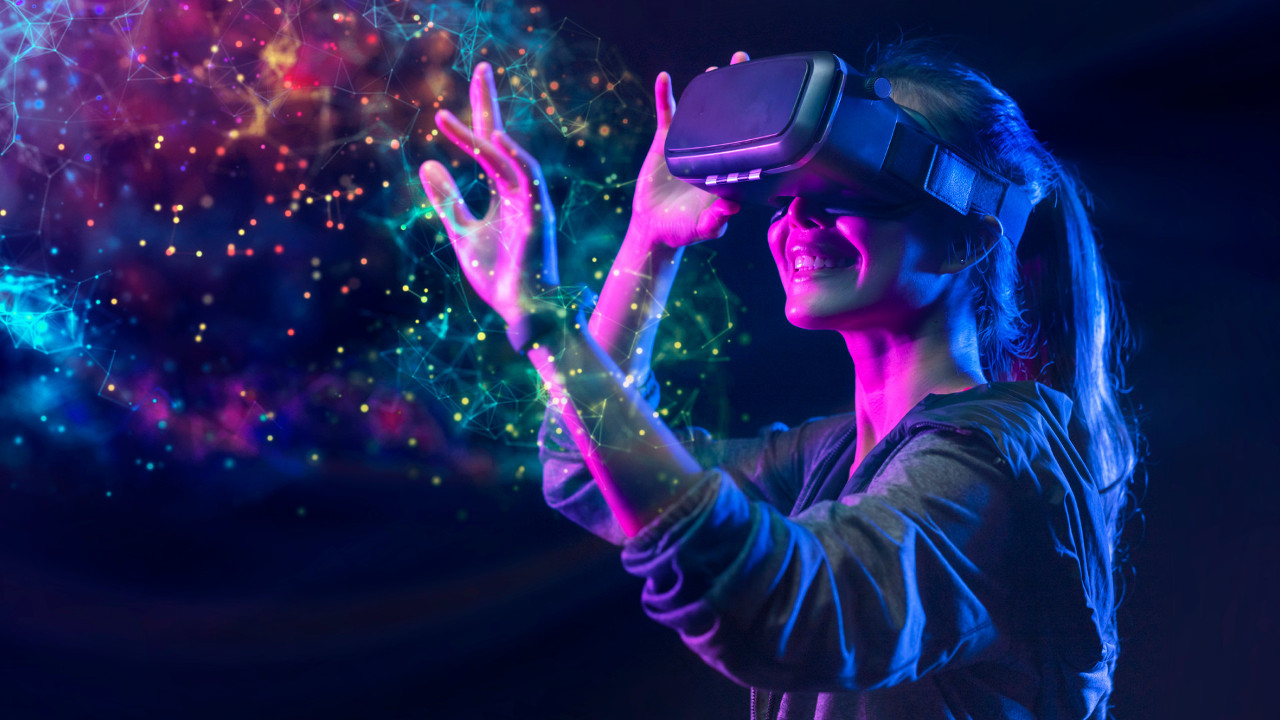- Definition of AR
- A brief history of AR technology
- Importance of AR in modern society
- Explanation of AR technology
- Components of AR systems
- Comparison with virtual reality (VR)
- AR in gaming and entertainment
- AR in education and training
- AR in healthcare
- AR in retail and marketing
- Enhancing user experience
- Improving learning outcomes
- Facilitating remote assistance
- Boosting sales and customer engagement
- Technical constraints
- Privacy and security concerns
- Adoption barriers
- Ethical considerations
- Integration with wearable devices
- Advancements in AR software
- Expansion into new industries
- Impact on society and culture
Recap of the significance of AR Encouragement for further exploration and innovation
Augmented Reality (AR)Augmented Reality (AR) is poised to revolutionize the way we interact with the world around us. With its ability to overlay digital content onto the physical environment, AR offers a unique and immersive experience that blurs the lines between the virtual and real worlds. From entertainment to education, healthcare to retail, AR is reshaping various industries and unlocking new possibilities for innovation and engagement.
Introduction to Augmented Reality (AR)
AR can be defined as a technology that superimposes computer-generated images, videos, or information onto a user’s view of the real world, thus enhancing their perception and interaction with their surroundings. Although the concept of AR has been around for several decades, recent advancements in hardware and software have propelled it into the mainstream, making it more accessible and practical than ever before.
A Brief History of AR Technology
The concept of Augmented Reality dates back to the 1960s when computer scientist Ivan Sutherland developed the first head-mounted display system known as the “Sword of Damocles.” However, it wasn’t until the late 20th and early 21st centuries that AR technology began to gain traction. In 1992, researchers Tom Caudell and David Mizell coined the term “Augmented Reality” while working at Boeing, where they used AR to assist aircraft assembly. Since then, AR has evolved rapidly, driven by advancements in hardware, software, and mobile computing. Today, AR is accessible through smartphones, tablets, and specialized wearable devices, revolutionizing various industries and reshaping the way we interact with digital content.
Importance of AR in Modern Society
Augmented Reality plays a crucial role in modern society by offering innovative solutions to a wide range of challenges and opportunities. In fields such as education, AR enhances learning experiences by providing interactive simulations, virtual tours, and immersive educational content. Similarly, in healthcare, AR is used for surgical planning, medical training, and patient education, leading to improved outcomes and patient care. AR also holds significant potential in gaming and entertainment, where it creates immersive and interactive experiences that captivate audiences and push the boundaries of storytelling. Moreover, AR is transforming industries such as retail, marketing, architecture, and manufacturing by enabling personalized shopping experiences, immersive advertising campaigns, and streamlined design processes. Overall, AR is driving innovation, enhancing productivity, and enriching lives across various sectors, making it an indispensable technology in the modern world.
How Augmented Reality Works
At its core, AR works by utilizing a combination of sensors, cameras, and display devices to detect the user’s environment and overlay digital content onto it in real time. This process involves three main components: input devices, processing units, and output displays. Unlike virtual reality, which creates entirely immersive simulated environments, AR enhances the existing physical world with digital elements, allowing users to interact with both simultaneously.
Augmented Reality (AR) works by integrating digital content into the user’s real-world environment, enhancing their perception and interaction with the surroundings. This process involves several key components working together seamlessly to create an immersive experience.
Components of AR Systems
-
- Input Devices: AR systems rely on various input devices to collect data about the user’s environment. These devices may include cameras, sensors, GPS receivers, and depth sensors. Cameras capture images and videos of the real world, while sensors gather information such as location, motion, and orientation.
-
- Processing Units: Once the input data is collected, it is processed by the AR system’s computing unit. This processing involves analyzing and interpreting the input data to understand the user’s surroundings and determine how to overlay digital content onto the real world. Advanced algorithms and machine learning techniques are often used to perform this processing in real-time.
-
- Output Displays: The final component of an AR system is the output display, which presents the augmented view to the user. This display can take various forms, including smartphones, tablets, smart glasses, and head-mounted displays (HMDs). Regardless of the form factor, the output display must be capable of superimposing digital content onto the user’s view of the real world, seamlessly blending the virtual and physical elements.
Comparison with Virtual Reality (VR)
While both Augmented Reality (AR) and Virtual Reality (VR) offer immersive digital experiences, they differ in their approach and functionality.
- AR vs. VR Environment: AR overlays digital content onto the user’s real-world environment, allowing them to interact with both virtual and physical elements simultaneously. In contrast, VR creates entirely virtual environments that immerse the user in a computer-generated world, blocking out the physical surroundings entirely.
- Interaction with the Environment: In AR, users maintain awareness of their real-world environment and can interact with physical objects while engaging with digital content. In VR, users are fully immersed in the virtual environment and interact primarily with virtual objects and spaces.
- Use Cases and Applications: AR is often used to enhance real-world experiences, such as navigation, education, training, and entertainment. VR, on the other hand, is commonly used for immersive simulations, gaming, virtual tours, and social experiences.
- Hardware Requirements: AR systems typically require less specialized hardware compared to VR systems. AR experiences can be accessed using smartphones, tablets, and wearable devices, whereas VR experiences often require dedicated headsets with built-in displays and motion-tracking sensors.
Applications of Augmented Reality
Augmented Reality (AR) has a diverse range of applications across various industries, revolutionizing how we interact with digital content and the physical world. Some notable applications include:
1. AR in Gaming and Entertainment: Augmented Reality has transformed the gaming and entertainment industry by offering immersive experiences that blend virtual elements with the real world. Games like Pokémon GO have popularized AR gaming, allowing players to interact with virtual creatures overlaid onto their surroundings. Additionally, AR technology enhances entertainment experiences by enabling interactive storytelling, immersive exhibitions, and live events with augmented visuals and interactive elements.
2. AR in Education and Training: In the field of education, Augmented Reality is used to create engaging and interactive learning experiences. AR educational apps and platforms provide students with immersive simulations, virtual laboratories, and interactive textbooks that make learning more engaging and effective. AR also facilitates hands-on training in fields such as science, engineering, and medicine, allowing learners to practice skills and procedures in a realistic virtual environment before applying them in real-world settings.
3. AR in Healthcare: Augmented Reality is transforming healthcare by enabling innovative applications in medical diagnosis, treatment planning, and patient care. Surgeons use AR technology to visualize anatomical structures in three dimensions during surgical procedures, enhancing precision and accuracy. Medical students and professionals utilize AR simulations and training modules to practice complex surgeries and medical procedures in a risk-free virtual environment. AR also enhances patient education by providing interactive visualizations of medical conditions and treatment options, empowering patients to make informed decisions about their health.
4. AR in Retail and Marketing: Augmented Reality is reshaping the retail and marketing landscape by offering immersive shopping experiences and innovative marketing campaigns. Retailers use AR apps and platforms to create virtual try-on experiences, allowing customers to preview products virtually before making a purchase. AR-powered marketing campaigns engage consumers with interactive advertisements, product demonstrations, and branded experiences that drive brand awareness and customer engagement. AR also enables personalized shopping experiences by providing tailored recommendations and virtual fitting rooms that enhance the overall shopping experience for consumers.
Advantages of Augmented Reality
1. Enhancing User Experience: AR enhances user experiences by overlaying digital content onto the real world, creating immersive and interactive environments. Whether it’s providing contextual information, guiding users through tasks, or delivering personalized recommendations, AR enriches interactions by adding a layer of digital information to the physical environment.
2. Improving Learning Outcomes: In education, AR improves learning outcomes by making abstract concepts more tangible and accessible. AR educational apps and platforms provide interactive simulations, virtual laboratories, and immersive learning experiences that cater to different learning styles and abilities, leading to improved retention and comprehension.
3. Facilitating Remote Assistance: AR facilitates remote assistance by enabling experts to provide guidance and support from a distance. Using AR-enabled devices, users can receive real-time instructions, annotations, and visual cues overlaid onto their surroundings, making troubleshooting, maintenance, and training more efficient and effective, regardless of location.
4. Boosting Sales and Customer Engagement: In retail and marketing, AR boosts sales and customer engagement by offering immersive shopping experiences and interactive marketing campaigns. AR enables virtual try-on experiences, product visualizations, and interactive advertisements that capture consumers’ attention, increase brand awareness, and drive sales conversions by providing a more engaging and personalized shopping experience.
Challenges and Limitations of Augmented Reality
Despite its numerous advantages, Augmented Reality also faces several challenges and limitations that need to be addressed:
1. Technical Constraints: AR technologies face technical constraints such as limited field of view, latency, and tracking accuracy, which can affect the overall user experience and immersion. Improvements in hardware and software are necessary to overcome these technical limitations and enhance the performance and reliability of AR systems.
2. Privacy and Security Concerns: AR raises privacy and security concerns related to data collection, tracking, and surveillance. As AR devices become more integrated into everyday life, it’s essential to address these concerns by implementing robust privacy protections and security measures to safeguard user data and ensure responsible use of AR technology.
3. Adoption Barriers: Adoption barriers, such as cost, accessibility, and complexity, may hinder the widespread adoption of AR technology. Overcoming these barriers requires reducing the cost of AR hardware, improving user interfaces and accessibility features, and providing comprehensive training and support to users to increase acceptance and adoption.
4. Ethical Considerations: AR raises ethical considerations related to data privacy, content moderation, and digital ethics. Developers and policymakers must consider the ethical implications of AR technology, including issues such as data privacy, bias, discrimination, and unintended consequences, to ensure the responsible use and development of AR systems that benefit society as a whole.
Conclusion
In conclusion, augmented reality represents a new era of interaction that promises to transform the way we perceive and engage with our surroundings. From enhancing entertainment experiences to revolutionizing education, healthcare, and retail, AR has the potential to revolutionize various aspects of our lives and unlock new opportunities for innovation and creativity. While challenges and limitations remain, the future of AR is bright, with exciting trends and developments on the horizon. By harnessing the power of AR responsibly and ethically, we can create a more immersive, connected, and enriching world for generations to come.









